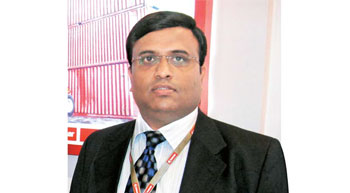Praveen Waychal, General Manager- Sales & Services, Cargotec India Pvt Ltd, speaks about the K-motion technology that reduces fuel consumption upto 40 per cent.
How much investment is projected in equipment over the next few years in government and private ports?
Minister for Shipping, Road Transport and Highways, Nitin Gadkari, has announced big investments in India´s ports and roads sector. These investments are the first step in economic growth, as well-laid infrastructure is a crucial need for improving the efficiency of cargo flow. The Indian government plans to develop 10 coastal economic regions, as part of plans to revive the country´s Sagarmala (string of ports) project. This year´s budget has seen the allocation of Rs.2.21 lakh crore for the infrastructure sector and it is a very crucial move to support and boost the limping infrastructure segment. Today the speed of delivery of cargo is affected due to congestion of roads; hence, allocation of Rs.97,000 crore for the road sector alone is a good decision for drastic improvements in this segment.
What are the product categories (forklifts, electric RTG cranes, etc.) that are going to drive the growth for Kalmar Global in the Indian cargo handling equipment market?
Kalmar, part of Cargotec, offers the widest range of cargo handling solutions and services to ports, terminals, distribution centres and to the heavy industry. The investments planned by the Government of India would require all types of equipment that we manufacture.
We supply quay cranes, RTGC, straddle carriers, shuttle carriers, reach stackers, empty container handlers, forklifts, terminal tractors, automatic stacking cranes, Bromma spreaders and Navis terminal operating systems. We also provide handling solutions to heavy industries and rental segment customers.
Where does Kalmar Global position itself in the Indian market?
Competition is always good for any industry as the key players keep on innovating and adding value for customers. Kalmar as a pioneer in many technologies in the port equipment segment, is proud to have world class technologically advanced products and customers do acknowledge this fact very openly.
In our industry, Kalmar has become a generic name for container handlers like how Xerox has become for any photocopier. Any manufacturer´s machines used in the industry for handling containers are called ´Kalmar´ and we are proud of this.
To what extent can new technologies help in reducing a freighter´s turnaround time?
As a leading equipment manufacturer, our role has always been crucial in introducing technologies to reduce the overall cost of operation for customers while improving the efficiency of cargo flows.
Kalmar is the pioneer in introducing path breaking technologies in raising the standards of performance and setting benchmarks of productivity, reliability and efficiency. We will face more and more stringent emission controls norms, volatile global fuel prices and availability, which necessitates us to reduce the reliance on conventional fuels and introduce technologies with alternative fuels which meet changing demands and needs. We have already seen the trend towards ships running on LNG for harbours where infrastructure is available.
Kalmar has created, in partnership with Global Services of Italy, a dual-fuel diesel and LNG powered Reachstacker which is a prototype. Our terminal tractors powered with engine running on LNG are already in operation in ports in China.
Last year, we have introduced Kalmar K-Motion, a technology used on reachstackers, which can achieve up to 40 per cent savings in fuel consumption. We also have all-electric RTG cranes installed in many countries.
So at Kalmar we are constantly tuned to the market to understand customer needs and address them with our solutions.
How challenging is it to remodel or overhaul an existing port with new equipment?
Kalmar is one of the most preferred brands when it comes to projects involved in refurbishments and overhauls of big cranes. We have a dedicated team doing these kinds of jobs and we do not restrict these services only to our equipment. We have done refurbishment relocation jobs of competitor make cranes also.
This is certainly challenging work and needs a deep understanding of engineering of cranes, project management skills and accurate diagnostic skills. We continuously invest in developing these skills and keep us ahead of our competition.
High initial investment required to install advanced cargo handling equipment is limiting the growth of electric and hybrid equipment particularly in the Asia-Pacific region, including India. Give us your assessment of the situation.
We agree that future technologies would have cost impact on the overall business model for many of our customers. However we are happy to see that Indian customers see the ´value trade-off´ with present model and future technologies. As we explained earlier, we will face more and more stringent emission controls norms, volatile global fuel prices and availability, which necessitates us to reduce the reliance on conventional fuels and introduce technologies with alternative fuels which meet changing demands and needs.
As a responsible industry player, we will continue to invest in futuristic eco-friendly technologies, as we have been doing in the past. We are confident that the customer would eventually see the value in such products for their long-term business model.
What do you see as major impediments in the path of technological modernisation of our ports?
Like every industry, ports are also facing challenges as you mentioned. However, economic reforms need to be a national agenda for everyone involved, so that we can see a holistic growth and economic development of the regions around ports. The only impediment for growth can be lack of business or cargo. Only domestic consumption in India is not going to help grow the Indian ports and port industry. ´Make in India´ needs to be a major support for us to develop an export-based economy, whereby many goods used in other parts of the world are made in India.
"We agree that future technologies would have cost impact on the overall business model for many of our customers.´
– RAHUL KAMAT



Leave a Reply
You must be logged in to post a comment.